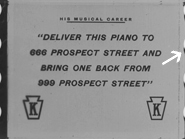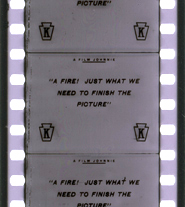Step 5 - The restoration work on A Film Johnnie
The dedicated staff of printing and processing operators carried out the restoration work in the lab. Grading was overseen by team leader Ben Thompson and David Hughes. Restoration work in a lab involves a great deal of testing - of both printer settings and, for black and white work, processing times. For example, contrast is lowered by faster processing times. As it happened, Ben wanted to increase the contrast of one of the source negatives to provide a better match with the other copies. This negative was printed to make a fine grain duplicating positive as usual but the duplicate negative was made on a stock with a higher contrast than duplicating negative stock. This not only matched the other copies better but also increased the apparent sharpness of the image.
As described above, an optical printer has many controls which allow the adjustment of an image in printing. For A Film Johnnie this capability was used in two significant instances.

Firstly, in some sections of the nitrate prints, the shape of the original negative's perforations could be seen quite clearly in the image. These sections were of a lower quality than the rest of the print because they were sections of dupe negative cut into the original negative, probably to substitute for damaged shots. After successive duplication, the shrinkage of the film meant the perforations had printed into the picture area. These shots were enlarged slightly and repositioned so that the perforations are no longer as visible in the new negative and prints.
The other adjustment carried out on the optical printer was the movement of the frameline position. The frameline is the line between frames (the picture area) on a film.

In the silent era the frameline was quite thin, because as much as possible of the area between every fourth perforation was used to carry picture information. However, the position of the frame in relation to the perforations, varied. A standard position today would be considered equidistant between two perforations but in the sources we were dealing with the framelines differed from that, and from each other.
It is not necessary to achieve a 'standard' position because a projector's gate can be moved to 'rack' the picture so that its full height is visible. What is important is to make the frameline consistent throughout a print, otherwise, in projection, the image will move up or down on the screen and the frameline may become visible. Anyone who watches old film regularly will know the frequency with which the racking has to be altered during screening. The optical printer was used to make these adjustments and realign the image consistently on the new negatives without cropping.

